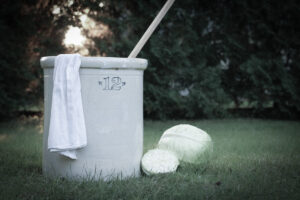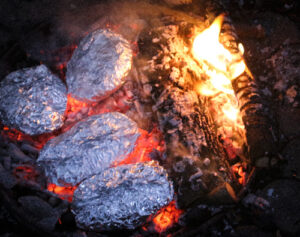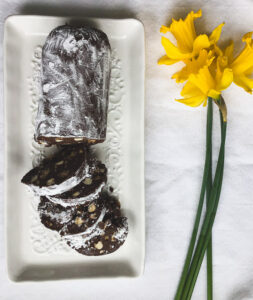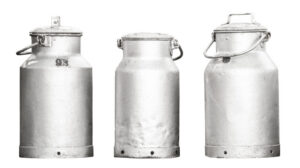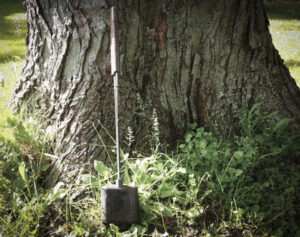Dr. Ryan Hanning
Chili Peppers & the Curious Case of Pleasant Pain

“Are you sure that is a bell pepper?” So goes a recent experience of pride before the fall. Ends up, despite my confidence otherwise, the small, beautiful orange pepper that melted my face for the next ten minutes was not its innocuous cousin. Lesson learned. Being beaten by such a tiny foe became an opportunity to dive deeper into the genetics and the long, complex relationship between humans and peppers.
Peppers have been part of the human diet for over 7500 years. Specifically cultivated for their spicy, high capsaicin varieties in the Americas since 4500 B.C. , the Aztec, Toltec, Mayan, and Incan civilizations all cultivated peppers for food and medicine, and to spice and preserve food. When Columbus landed in the New World, in part to secure cheaper access to spices, he confused the bite of the local capsicum fruit with that of the highly valuable black pepper. According to at least one story, he believed the spice to provide further evidence that he was indeed in India, writing in his journal that he found “Indies pepper.” Thus, the origin of the “pepper” to the new world, like so many other stories, began without a proper name. The local Nahuatl word was “chilli” and this proper title was affixed as an early corrective. Chili peppers were broadly rejected in Europe as too strong and relegated to the status of “poor man’s pepper.” But the lucrative sugar and spice trade from the New World to the Orient soon made the chili pepper a valuable commodity and the stuff of legends.
At one point, an estimated seventy percent of the international spice trade was in new world peppers. Portugal dangerously broke the Treaty of the Tordesillas in order to export chili peppers throughout Arabia and Asia where varieties of searing hot peppers integrated well into an already spice rich cuisine. The humble chili pepper, capsicum annum, and its thousands of local variants both hot and mild were quickly adapted and grown locally becoming a staple in diets throughout the world. While there is broad agreement about the origins and impact of the peppers among food and ethno-historians, scientists are less unanimous about the specific origins of domesticated peppers in Meso-America. The most current theory places the first domestication in North Eastern Mexico. The historical, political, and scientific origins are interesting, but more so is the tremendous amount of human knowledge collected over this time. This knowledge allows growers, pro and novice alike, to choose from over 50,000 varieties within five domesticated species of capsicum. Growers can accentuate features of each plant in response to climate, growing season, and genetics which have been selected for and safeguarded for generations.
The Pain We Love to Eat
The United States is one of the top five consumers of hot peppers in the world. The chili pepper has become American’s preferred source of spiciness with the hot sauce industry raking in over $1.5 billion dollars annually. Its sweet heat is distinct and complex. Black pepper still occupies pride of place next to salt at most dinner tables, however its flavor profile is more limited. Derived from the ground berry, or peppercorn, of the piper nigrum, native to the Malabar coast of Indian it is more pungent than sweet.
While different varieties have more complex flavors, the black pepper that usually adorns our tables is pretty one dimensional. Black peppers produce their spice from a compound called piperine found in their berries. Capsicums produce their spice from the compound called capsaicin found in their skin, membrane and especially their seeds. Both piperine and capsaicin cause a fierce reaction not so much on the tongue, but in the brain. The fierce reaction is a hiccup on our TRPV1 receptor which registers heat. While there is no tissue damage, the brain ignites and responds in the same way it would to something legitimately burning us. Thus, the resulting reaction and subsequent pain, sweating, and swelling. While both piperine and capsaicin are agonist of our TRPV1 receptors they work in different and complex ways.
By comparison, the strength and duration of capsaicin is truly unique. Surprisingly, there are a lot of scientific studies on the specific effects of these compounds in the body and their associated medical benefits. Piperines actually cause greater activity in the receptors but simultaneously desensitize the receptors to the associated pain, often described as a “knock” “zing” or “kick.” Capsaicin on the other hand has a less intense receptor activity but provide the receptors no desensitization. In other words, you feel and taste the full experience with capsaicin. It “burns” “throbs” “ignites and spreads.” There are some complicated molecular reasons for this that deal with protein bindings, alkaloids and vanilloid vs. non vanilloid congeners. But suffice to say, chili peppers seem to beat up your receptors while simultaneously sensitizing them to the beating. Capsicum’s developed this curious ability not only to deter mammals from eating their fruit, but more importantly to deter fungi and other microbes from growing; a property our ancestors exploited to preserve food. These compounds and the resulting neurological reactivity, along with unique and complex fruit flavors that underlay the spice, make chili peppers a unique culinary experience and a scientific marvel.
Finding the Right Pepper
Chili peppers come in a variety of shapes, sizes, colors, and heat. In fact, there is a scale of measurement dedicated to scientifically determining the available and active capsaicin levels in peppers. Ranging from 0-16,000,000, the Scoville Scale (SHU) first developed in 1912, measures how many parts sugar water is necessary to dilute a solution until the pepper no longer fires our TRPV1 receptors.
The bell, jalapeno, habanero, and ghost pepper are all varieties of chili peppers but knowing the properties of each can make the difference between a good meal and a good story. Bell is the baseline at 0 (SHU), the jalapeno 2500-8000 (SHU) about the same heat as Siracha sauce, habanero 150,000-325,000 (SHU) and the ghost pepper is 800,000-1,001,300 (SHU). And there are hotter varieties. The one that inspired this article was an orange habanero which originated in the Amazon and measures around 150,000-300,000 (SHU). Keep in mind that there are peppers that are 10 times hotter. Intermingled with the heat are unique flavor profiles that are popularized in cuisines throughout the world. The datil pepper and its intense fruity heat, the Thai pepper and its bright, sweet heat, the ghost pepper and its fruity effervescent heat and the Carolina reaper with the long list of bad decisions that lead up to eating it.
With so many available varieties you can be creative, and most nurseries have several unique options on hand.
When planting peppers in your garden, it is important to select the variety you want and understand how its unique characteristics will be affected by soil chemistry, climate, and genetics. It is also important to know that peppers are self-pollinating, they do not rely on other plants to fruit, but other plants will indeed contribute pollen. Growing a mild variety next to a spicy variety will in fact change the next generation of fruit. Either spicing up the sweet pepper and/or calming down a hot pepper. The current fruit will not be impacted, as their genetics are determined by the mother plant, but the seeds will have half of the DNA from the pollinating plant, and future generations may be impacted. If you want to save seeds and avoid hybrids, make sure you separate different varieties by at least 500 feet.
For sweet peppers, bells, California wonders, Anahiems or hatch (which can be a little spicy) are all proven growers in most areas.
For spicy peppers, beware of expensive super spicy hybrids these can be difficult to grow outside of a commercial setting.
Go with some trusted local varieties or well proven jalapenos, habaneros, or poblanos. Depending on your climate and zone you may also find some unique Caribbean variety.
For drying peppers, several varieties do well. Anchos (dried poblanos), Aji panca from Peru and Cayenne are some of the most popular. You can even make your own chipotle by drying and smoking jalapenos.
Selecting Seed or Plant
Find a variety that you like and one that other growers have success growing in your area. Source good quality seed or young plants from a reputable grower. For seeds you are looking for a grower who cultivates seeds and stores seeds in a responsible way. Usually this means cultivating seeds from healthy plants with good genetic properties that you want. In the ancient world seeds were currency. Good seeds can make all the difference. We prefer organic, non-gmo, heirloom varieties when possible, and have had better success with them, than commercial fast-growing or high-yield varieties. Investing in good seed and getting a healthy plant not only means more food for you, but also more healthy seeds for future planting.
If purchasing a starter, look for a healthy plant with good, even leaf coloration, a stout stem, and several offshoots from the trunk. This does not necessarily mean the biggest, in fact, often the biggest starter plant may be too mature for the small container they are in and are likely root bound which will stunt its growth.
When to plant: In North America, the time to plant peppers is after the last Spring frost. Ideally you want soil temperatures that are above 75°F.
Preparing the Soil: Peppers can typically take full sun in most climates if they have enough water. They need a good loamy soil that provides moisture but drains well with lots of rich organic material. Space plants 12-24 inches apart in rows that are at least 12 inches apart.
Planting from Seed: Because sweet peppers can take between 60-90 days and hot peppers up to 150 days till harvest, you should plan ahead. Most people start seeds inside 6 to 8 weeks before planting. They grow good size seedlings to transplant in the Spring. If you buy seeds, start them on a moist paper towel, just like you did in grade school. Once the seed starts to germinate (typically 14-18 days) and you can see the little root starting, it is time to plant it. Place the seed root side down about ¼ to ½ inch deep in the appropriate pot with the right soil. The pot size depends on how long you will keep them in pots before planting. A 2-inch pot is fine if you will get them in the ground within 4 weeks. A 4-inch pot is recommended if they will be planted later than 4 weeks. Make sure your starters get plenty of light and daily watering. Make sure that the soil can drain. Standing water can lead to root rot, and gnats. We prefer bottom watering to encourage deep root growth. Set the potted plant in shallow dish of water and wait until it wicks up the water and the top of the soil is moistened.
Starting seeds inside can attract some pests, a little cinnamon or sand on the very top layer of soil can help deter most common pests. We have found that it helps to gently blow or brush your hand across the top of young seedlings to help them grow more resistant to wind and the outside. We are not sure if it works, but it makes us feel better. When you are ready to transplant your seedlings outside prepare them well by “hardening them off.” This means gently letting them acclimate to the sun, heat, and temperature swings of outdoors. We usually stick our plants outside during the day and bring them in at night and vice-versa a few times in the days preceding their planting.
Planting a starter: Once you have found your starter or grown it from seed, get it in the ground. Prepare the soil bed where you are planting by digging a hole roughly the same size as your planter. Gently remove the plant from its pot and loosen up the soil around its roots. Stick it in the hole, fill in the soil to no higher than the original height of the soil in the pot. Water your plant thoroughly. From this moment on, watch for two things. 1) Check daily if it needs water by stick your finger about a half inch into the ground a few inches from the plant. If the ground feels cool and moist, it does not need water, it is feels warm and dry, give it some water. 2) If the forecast is dropping drastically to below 40 degrees, cover your plant during the cold time, and uncover it when the sun comes out.
Harvesting: Check the growing schedule and pepper size for the variety you picked. Green peppers are typically harvested as young fruits, other varieties will change color as they ripen. When you start to see good size peppers on the plant, cut one off and give it a try. If it is too young, or too ripe you will know and can use your knowledge to harvest accordingly.
Preparing: Peppers are an incredibly versatile fruit and can be eaten raw, sautéed, stuffed, dried, or made into fresh salsa. Some, like the ancient Aztec even use peppers to garnish drinks or make spicy hot chocolate—just for the record “chocolate” is another Nahuatl word.
If you were brave enough to grow hot peppers, remember the membrane and seeds are typically a lot hotter than the fruit itself. Use caution if cooking with hot peppers. Taste often, a little can go a long way. Also, the capsaicin compound is naturally suspended in oil and is therefore not water soluble. Mind your eyes, wash well with soap, and use gloves if dealing with really hot varieties.



